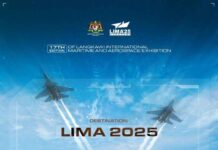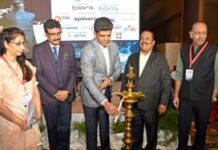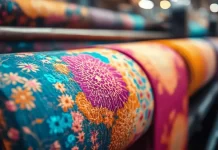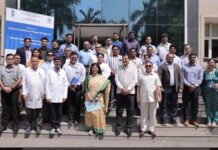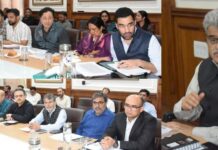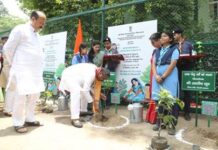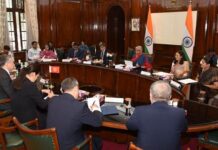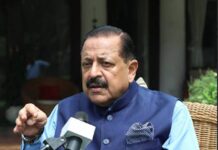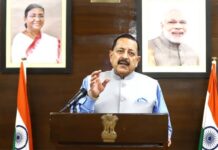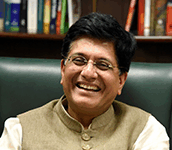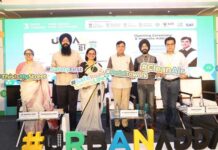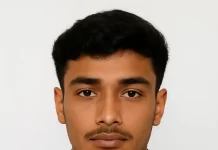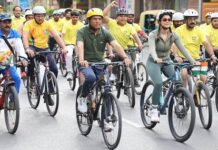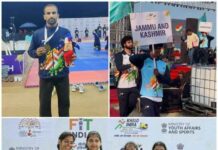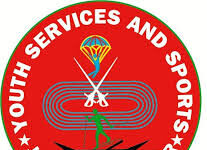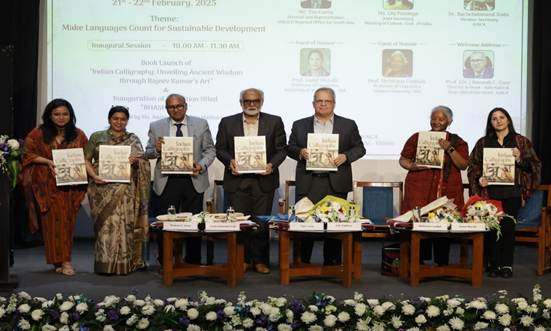22 FEB, 2025: Indira Gandhi National Centre for the Arts (IGNCA) commemorated International Mother Language Day with a two-day celebration on 21st and 22nd February 2025. Centred on the theme ‘Make Languages Count for Sustainable Development’, the event brought together eminent scholars, linguists, and cultural experts to deliberate on the role of languages in fostering sustainable growth. The inaugural session on 21st February featured the launch of ‘Indian Calligraphy: Unveiling Ancient Wisdom through Rajeev Kumar’s Art’, alongside the inauguration of the exhibition BHASHARRITI, curated by Ms. Aashna and Ms. Ritu Mathur. The occasion was graced by Mr. Tim Curtis, Director and Representative, UNESCO Regional Office for South Asia, as Chief Guest, and Ms. Lily Pandeya, Joint Secretary, Ministry of Culture, Government of India, as Special Guest. The session was chaired by Dr. Sachchidanand Joshi, Member Secretary, IGNCA, and the welcome address was delivered by Prof. Ramesh Chandra Gaur, Director & Head- Kala Nidhi and Dean (Administration), IGNCA. The event provided a dynamic platform for insightful discussions, reinforcing a collective commitment to preserving and promoting linguistic heritage.
Mr. Tim Curtis, while delivering his address, emphasised that celebrating International Mother Language Day is deeply personal and universally significant, as it honours the languages that shape our thoughts and words. More than mere tools of communication, languages define identities and connect individuals to their histories and communities. Highlighting South Asia’s rich linguistic landscape, he noted that research indicates over 7,000 languages are endangered, with indigenous languages being the most vulnerable. These languages encapsulate unique knowledge systems and millennia of wisdom, making their loss a threat to cultural heritage.
He referred to the United Nations’ declaration of 2022–2032 as the Decade of Indigenous Languages, aimed at documentation, revitalisation, and celebration of linguistic treasures. He acknowledged IGNCA’s ongoing contributions in this regard and expressed gratitude for organising Mother Language Day. Stressing the importance of multilingual education, he cited India’s National Education Policy as a model for embracing linguistic diversity, enhancing both learning outcomes and national unity. UNESCO, he affirmed, is scaling up efforts for indigenous language preservation, advocating community-led initiatives that bridge linguistic communities and foster equity.
Mr. Tim Curtis concluded by stating that language is not just a tool for communication but, in a way, a passport to understanding humanity itself. When we speak in our mother tongue, we do not merely exchange words but share ways of perceiving and interpreting the world. By honouring each other’s mother tongue, we facilitate understanding that transcends borders and cultures.
Dr. Sachchidanand Joshi, in his chair remarks, stated that it is always a pleasure to acknowledge that India is a nation with one of the highest numbers of languages and dialects. With over 1,700 languages once spoken across the country, this linguistic wealth has long been a matter of pride. However, the other side of the coin is the rapid decline of languages, with many disappearing at an alarming rate, an issue that warrants serious concern. He emphasised that collective efforts are being made to preserve and promote languages, and the National Education Policy rightly places significant emphasis on education in one’s mother tongue. While discussing language, he noted that it consists of three fundamental components-language itself, script, and phonetics. He pointed out that among these, phonetics remains the most overlooked aspect in conversations about mother tongues. Without attention to phonetics, he asserted, a language remains incomplete.
Prof. Ramesh Chandra Gaur, while speaking at the event, emphasised that there can be no disagreement about the importance of any language. He observed that the linguistic landscape has been evolving in the wake of globalisation. While acknowledging the rising number and percentage of people conversing in English, he clarified that this is not a matter of concern. Instead, he accentuated the real issue-people increasingly refraining from speaking in their mother tongue. Stressing the significance of multilingualism, he asserted that being multilingual is not just beneficial but essential for sustainable development. He further asserted that languages can only be preserved if communities continue to speak and engage with them actively in their daily lives.
The first day featured three panel discussions. The first session, titled ‘Make Languages Count for Sustainable Development’, was moderated by Prof. Ramesh Chandra Gaur. The panel included Prof. Shobhana Chelliah from Indiana University, USA; Prof. Sadaf Munshi from the University of North Texas, USA; and Dr. Huma Masood, Senior Gender Specialist at UNESCO’s New Delhi Office. The second session focused on a discussion of the book Indian Calligraphy: Unveiling Ancient Wisdom through Rajeev Kumar’s Art. The panel comprised Ms. Jaya Jaitly, Founder of Dastkari Haat Samiti, New Delhi; Prof. Ramesh Chandra Gaur; and cultural entrepreneur and exhibition curator Ms. Ritu Mathur.
The third session explored the theme ‘National Education Policy and Indian Languages’. Moderated by Mr. Sudhakar Pathak, President of the Hindustani Bhasha Academy, the session featured insights from Prof. Bandana Jha of Jawaharlal Nehru University’s Department of Indian Languages; Dr. Pawan Vijay of Guru Gobind Singh Indraprastha University; Dr. Alok Ranjan Pandey of Ramanujan College, University of Delhi; and Dr. Vijay Kumar Mishra of Hansraj College. The event witnessed a significant gathering of language enthusiasts, academicians, and researchers, reaffirming the commitment to linguistic preservation and discourse.

